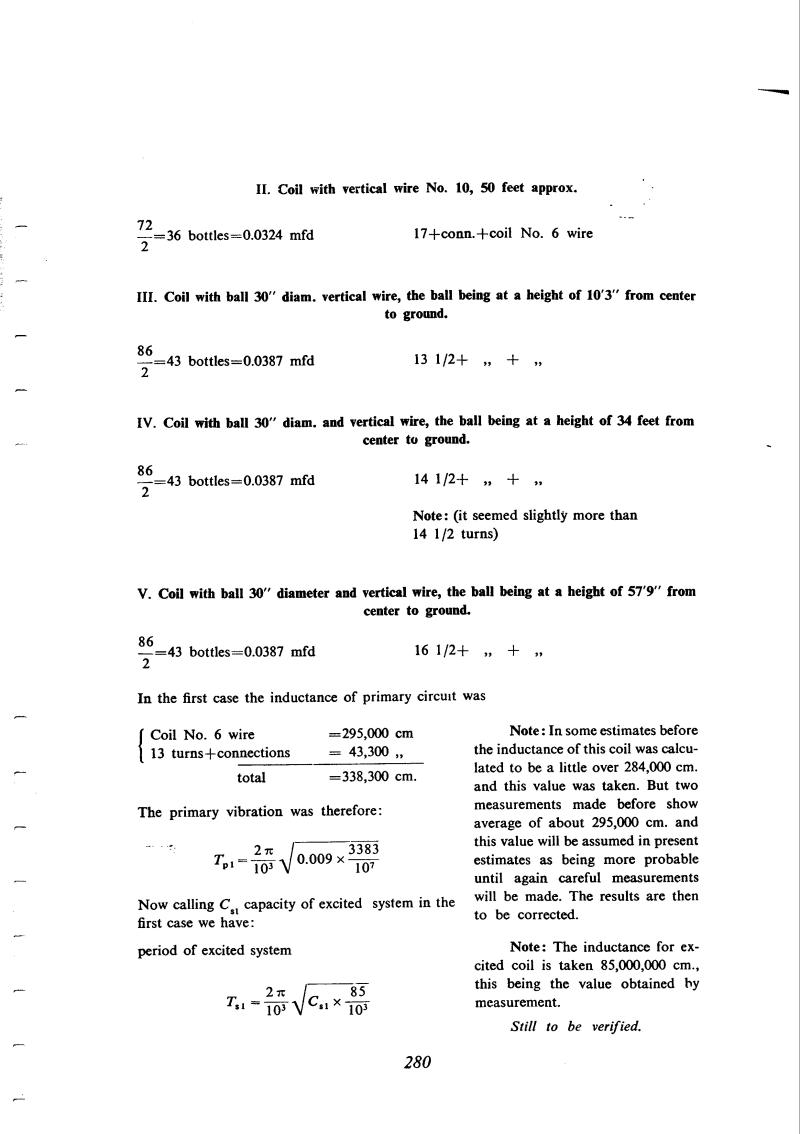
Nikola Tesla Books
| II. Coil with vertical wire No. 10, 50 feet approx. | |
| $! {72 \over 2} $! = 36 bottles = 0.0324 mfd | 17 + conn. + coil No. 6 wire |
| III. Coil with ball 30" diam. vertical wire, the ball being at a height of 10â3" from center to ground. | |
| $! {86 \over 2} $! = 43 bottles = 0.0387 mfd | 13 1/2 + " + " |
| IV. Coil with ball 30" diam. and vertical wire, the ball being at a height of 34 feet from center to ground. | |
| $! {86 \over 2} $! = 43 bottles = 0.0387 mfd | 14 1/2 + " + "
Note: (it seemed slightly more than 14 1/2 turns) |
| V. Coil with ball 30" diameter and vertical wire, the ball being at a height of 57' 9" from center to ground. | |
| $! {86 \over 2} $! = 43 bottles = 0.0387 mfd | 16 1/2 + " + " |
In the first case the inductance of primary circuit was
| { | Coil No. wire | = 295,000 cm | |
| 13 turns + connections | = 43,000 " | ||
| total | = 338,300 cm. | ||
The primary vibration was therefore:
Tp1 = $! {{2 \pi \over 10^{3}} \sqrt{0.009 \times {3383 \over 10^{7}}}} $!
Now calling Cs1 capacity of excited system in the first case we have:
period of excited system
Ts1 = $! {{2 \pi \over 10^{3}} \sqrt{{C_{s}}_{1} \times {85 \over 10^{3}}}} $!
| Note: In some estimates before the inductance of this coil was calculated to be a little over 284,000 cm. and this value was taken. But two measurements made before show average of about 295,000 cm. and this value will be assumed in present estimates as being more probable until again careful measurements will be made. The results are then to be corrected. Note: The inductance for excited coil is taken 85,000,000 cm., this being the value obtained by measurement. |
| Still to be verified. |
280
November 11
In measuring the capacity of a sphere at different heights Tesla here uses a loosely coupled circuit containing a lamp to determine resonance. The results for a 50 ft wire differ somewhat from those of October 28th, but are within the limits of error of the method. The values for the capacity of the sphere are somewhat higher than before, but not in proportion to the diameter of the sphere.
November 11
He continues for measurements of the sphere capacitance changes at various elevations above the ground. For the purpose of determining the resonance he uses the circuit weakly coupled with the bulb. The results for the wire 50 ft. in length are somewhat different from those obtained Oct. 28, but the differences are within the limits of measurement accuracy. The values for the sphere capacitance are somewhat higher than previous, but they are not increased proportionately in relation to the sphere diameter.

